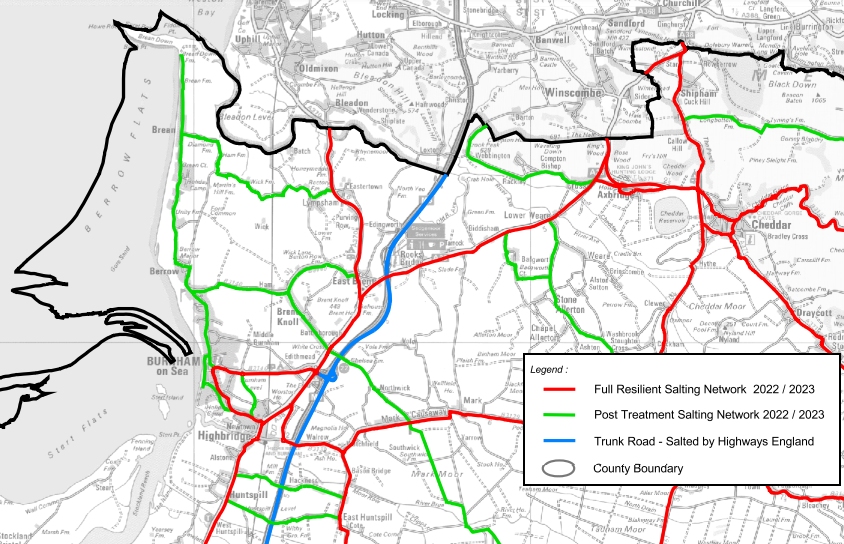Somerset County Council has announced which roads in the Burnham-On-Sea and Highbridge area will be gritted this winter.
The priority for the 23 gritters in Somerset will be “roads that link major towns, villages and communities on high ground and the important routes across the County for long distance travel,” says the council.
Salt barns across Somerset are fully stocked and over the past week the gritters have headed out on a trial run across the county’s network. The team says it is on standby to treat 900 miles of road whenever the mercury plummets.
The new gritting map here shows that in the Burnham-On-Sea area, the M5 through our area will be gritted as normal by National Highways South West, formerly Highways England.
Queen’s Drive, Love Lane, Oxford Street, Burnham Road and Highbridge Road and the A38 to the M5 junction at Edithmead are also on the gritting map, shown below.
The main A38 / A370 from Highbridge to East Brent and north to Weston is on the map to be gritted as well. The B3139 and Causeway between Mark and Wedmore is also included, as is the A38 between Rooksbridge and Axbridge.

“Our gritting network covers all last year’s routes plus it has been increased slightly this winter,” says a spokesman.
Last year, the council’s fleet of nearly two dozen gritters went out on 59 occasions when freezing temperatures were forecast, covering 45,000 miles to help prevent ice forming with 1181 route actions in total.
“As days become shorter and evenings colder, safety on our roads remains paramount to us. Our dedicated teams in each of our depots are ready and have ensured all equipment is checked, and our salt is stocked throughout the warmer months,” said Somerset County Council’s lead member for Transport and Digital, Councillor Mike Rigby.
“While temperatures currently remain mild, rest assured the team are checking the forecasts every day to ensure gritters are ready to go out.”
The council says it carried out gritting when road surface temperatures are predicted to drop below 1°C and ice or snow is expected. Precautionary ritting normally takes place before the formation of ice – so that generally means teams are out in the evening or early morning.
In the event of snow, the council says it has ‘established plans’ in place, working alongside the emergency services and partners to clear the network as quickly as possible. It can equip its gritters with snowploughs and has arrangements with farmers and snowplough operators who are employed to clear snow on the council’s behalf. It also prioritises the primary network and moves on to clear the secondary and minor networks as resources allow.
“We can’t treat every road, as there aren’t enough gritters, drivers and depot staff to make this cost-efficient. However, we are carrying on our work with parish councils to fill roadside grit bins on request and are continuing to run a community-led snow warden scheme,” adds a spokesman.
“Rain can wash salt away and in very low temperatures gritting may not be enough to prevent freezing – so drivers are always advised to take extra caution in winter.”
This year a call is also going out to farmers across Somerset to support the Council’s winter services with snow ploughing duties should conditions become challenging. Farmers are paid for this important work they undertake to support their communities. If you can help, contact somerset.winter@







